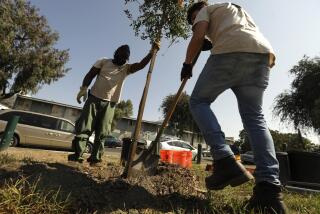Will replacing thirsty lawns with drought-tolerant plants make L.A. hotter?
- Share via
Last summer, a revolution occurred in Los Angeles landscaping: Across the city, tens of thousands of homeowners tore up their water-thirsty lawns and replaced them with gravel, turf, decomposed granite and a wide range of drought-tolerant plants at a rate never seen before.
The water-saving benefits of this massive landscape overhaul are undisputed — and that’s important in a region that was facing what researchers called the worst drought in 1,200 years. Still, some experts warned that Angelenos’ zeal to use less water in the backyard would ultimately make the city warmer.
“Gardens and lawns act as air conditioning for L.A., which is only getting hotter with climate change,” landscape designers Mia Lehrer, Claire Latané and Margot Jacobs wrote in a 2015 op-ed in the Los Angeles Times. “Plants and trees provide shade and transpire moisture to cool the air; gravel and artificial turf don’t.”
The trio advocated replacing water-hungry landscapes with living landscapes that require almost no irrigation at all. But an environmentally sensitive Angeleno might still find herself confused: Could even savvy drought-tolerant landscaping cause the city to heat up?
Now there is a scientific answer to that question.
In a paper published Monday in Geophysical Research Letters, University of Southern California post-doctoral research associate Pouya Vahmani and USC civil and environmental engineering professor George Ban-Weiss analyze what would happen to the city’s overall temperature during the month of July if every lawn were replaced with drought-tolerant plants.
After running different land-cover scenarios through a climate model tailored to Los Angeles’ unique mix of coastal breezes, mountains and expansive urban cover, the authors report that a lawn-less Los Angeles would be up to 3.4 degrees warmer during the day than it is now. As expected, this warming would mostly be due to decreases in irrigation, the researchers said.
But there’s a flip side. The authors also report that transforming lawns to drought-tolerant vegetation has an average nighttime cooling effect of about 5.4 degrees that more than makes up for the daytime warming.
“We hypothesized that our model would predict daytime warming, but we did not anticipate the nighttime cooling signal,” Ban-Weiss said. “In retrospect, it makes sense that reducing soil moisture would change the thermal properties of the soil and surface-atmosphere coupling in this way.”
The researchers also considered how the average summertime temperature would be affected if all the city’s vegetation — lawns and trees — were ripped out and replaced with drought-tolerant shrubs.
In this scenario, they found that the average daytime air temperatures actually dropped by 0.4 degrees. That’s because, with no trees in Los Angeles, sea breezes would blow through the region unhindered by tree trunks, counteracting the warming you’d expect from the lack of irrigation.
Not that anyone is suggesting Angelenos chop down trees.
“Trees are valuable for providing shade, improving pedestrian thermal comfort, and have a plethora of other societal benefits,” Ban-Weiss said. “That scenario was used as a very hypothetical one to help us better understand the science.”
Perhaps the greatest takeaway of the study, he added, is that when it comes to the climate in Los Angeles, nothing is ever simple.
Do you love science? I do! Follow me @DeborahNetburn and “like” Los Angeles Times Science & Health on Facebook.
MORE IN SCIENCE
Martian gully theory doesn’t hold water, study finds
Deep space travel might blow your mind, but it could be bad for your heart
Scientists find only one true wolf species in North America







